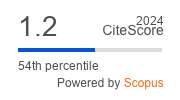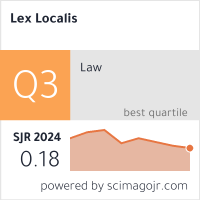Merjenje transparentnosti lokalnih ravni upravljanja. Vpliv političnega znaka v večdimenzionalni analizi
DOI:
https://doi.org/10.4335/15.4.889-917(2017)Ključne besede:
transparentnost, e-uprava, večdimenzionalna primerjava, indeks transparentnosti, lokalne ravni upravljanjaPovzetek
V zadnjih letih je postala transparentnost ključni element v interakciji med javnimi upravami in družbo. Vseeno pa je to širok pojem, ki ga je treba opredeliti in previdno izmeriti. Različni avtorji so obravnavali ta pojem z vidika različnih področij prek oblikovanja dihotomnih indeksov transparentnosti, a brez merjenja kakovosti informacij. V pričujoči študiji predlagamo novo metodo za merjenje kakovosti in vsebine razkrivanja občinskih informacij, pri čemer se izogibamo oblikovanju sintetičnega indeksa in poudarjamo elemente transparentnosti, ki prinašajo optimalno kvalitetne in kvantitetne informacije. Nadalje prepoznamo razlike med lokalnimi ravnmi upravljanja in različnimi političnimi ideologijami z uporabo analize večdimenzionalne primerjave. Pridobljeni rezultati kažejo, da dajejo konzervativne ravni upravljanja v primerjavi s progresivnimi večji pomen kazalnikom transparentnosti, zlasti kar zadeva pravne in institucionalne informacije.
Literatura
Alcaide-Muñoz, L., & Rodríguez-Bolívar, M. P. (2015) Determining factors of transparency and accountability in local governments: A meta-analytic study, Lex Localis, 13(2), pp. 129-160.
Alcaraz-Quiles, F. J., Navarro-Galera, A. & Ortiz-Rodríguez, D. (2014a) Factors influencing the transparency of sustainability information in regional governments: an empirical study. Journal of Cleaner Production, 82, pp. 179-191.
Alcaraz-Quiles, F. J., Navarro-Galera, A., & Ortiz-Rodríguez, D. (2014b) A Comparative Analysis of Transparency in Sustainability Reporting by Local and Regional Governments, Lex Localis, 12(1), pp. 55-78.
Alcaide-Muñoz, L., Rodríguez-Bolívar, M. P. & López-Hernández, A. M. (2016) Transparency in governments a meta-analytic review of incentives for digital versus hard-copy public financial disclosures, The American Review of Public Administration, pp. 1-34.
Archel, P., Husillos, J., Larrinaga, C., & Spence, C. (2009) Social disclosure, legitimacy theory and the role of the state, Accounting, Auditing & Accountability Journal, 22, pp. 1284-1307.
Breul, J. D. (2007) Three Bush Administration management reform initiatives: The President’s management agenda, freedom to manage legislative proposals, and the program assessment rating tool, Public Administration Review, 67(1), pp. 21–26.
Da Cruz, N. F., Tavares, A. F., Marques, R. C., Jorge, S. & de Sousa, L. (2015) Measuring local government transparency, Public Management Review, 18(6), pp. 866-893.
Frías-Aceituno, J. V., Rodríguez-Ariza, L. & González-Bravo, M. I. (2013) The Effect of Societal Values on Local Government Transparency: Applying Hofstede's Cultural Dimmensions, Lex Localis, 11(4), pp. 829-850.
García-Sánchez, I. M., Frías-Aceituno, J. V. & Rodríguez-Domínguez, L. (2013) Determinants of corporate social disclosure in Spanish local governments, Journal of Cleaner Production, 39, pp. 60-72.
Garrido-Rodríguez, J.C., López-Hernández, A. M. & Zafra-Gómez, J. L. (2016) A methodological proposal to measure transparency in Spain: ITA and STI Rankings compared, In: Cuadrado-Ballesteros, B. & García-Sánchez, I. M. (eds.) Local Governments in the Digital Era: Looking for Accountability (New York: Nova Science Publishers).
Grimmelikhuijsen, S., Porumbescu, G., Hong, B. & Im, T. (2013) The effect of transparency on trust in government: A cross‐national comparative experiment, Public Administration Review, 73(4), pp. 575-586.
Guillamón, M. D., Bastida, F. & Benito, B. (2011a) The determinants of local government’s financial transparency, Local Government Studies, 37(4), pp391–406, doi:10.1080/03003930.2011.588704
Guillamón, M. D., Ríos A. M. & Vicente, C. (2011b) Transparencia financiera de los municipios españoles. utilidad y factores relacionados, Auditoría Publica, 55, pp. 109-116.
Islam, R. (2003) Do more transparent governments govern better?, World Bank Policy Research Working Paper (3077) (Washington DC: World Bank).
Jorge, S., Sá, P. M. E., Pattaro, A. F. & Lourenço, R. P. (2011) Local government financial transparency in Portugal and Italy: A comparative exploratory study on its determinants, In: 13th Biennial CIGAR Conference, Bridging Public Sector and Non-Profit Sector Accounting, Ghent, June.
Kauffmann, D., & Kraay, A. (2002) Growth without Governance, Policy Research Working Paper No. 2928 (Washington DC: World Bank).
Kim, S. & Lee, J. (2012) E‐participation, transparency, and trust in local government, Public Administration Review, 72(6), pp. 819-828.
Kruskal, J. B. (1964) Multidimensional scaling by optimizing goodness of fit to a nonmetric hypothesis, Psychometrika, 29(1), pp. 1-27.
Kruskal, J. B. (1976) More factors than subjects, tests and treatments: an indeterminacy theorem for canonical decomposition and individual differences scaling, Psychometrika, 41(3), pp. 281-293.
Laswad, F., Fisher, R. & Oyelere, P. (2005) Determinants of voluntary Internet financial reporting by local government authorities, Journal of Accounting and Public Policy, 24(2), pp. 101-121.
Lourenço, R. P., Moura, P., Jorge, S. & Pataro, A. F. (2013) Online transparency for accountability: One assessing model and two applications, Electronic Journal of e-Government, 11(2), pp. 280-292.
Mack, J., & Ryan, C. (2006) Reflections on the theoretical underpinning of the general-purpose financial reports of Australian government departments, Accounting, Auditing & Accountability Journal, 19, pp. 592-612.
Magdaleno, A. & García-García, J. (2014) Evaluación de la transparencia municipal en el Principado de Asturias, Auditoría Pública, 64, pp. 75 – 86.
Matheson, A. (2002) Better public sector governance: the rationale for budgeting and accounting reform in Western nations, in models of public budgeting and accounting reform, OECD Journal on Budgeting, 2(1), pp. 37 – 49.
Mathews, M. R. (1993) Socially Responsible Accounting (London: Chapman & Hall).
Meijer, A. (2003) Transparent government: parliamentary and legal accountability in an information age, Information Polity, 8(1-2), pp. 67 – 78.
Mergel, I. (2013), Social media adoption and resulting tactics in the U.S. Federal Government, Government Information Quarterly, 30, pp. 123-130.
Navarro, A., Alcaraz, F.J. & Ortiz, D. (2010) La divulgación de información sobre responsabilidad corporativa en administraciones públicas: Un estudio empírico en gobiernos locales, Revista de Contabilidad, 13(2), pp. 285-314.
Ni, A. Y. & Bretschneider, S. (2007) The decision to contract out: a study of contracting for e‐government services in State governments, Public Administration Review, 67(3), pp. 531-544.
Piotrowski, S. J. & Van Ryzin, G. G. (2007) Citizen attitudes toward transparency in local government, The American Review of Public Administration, 37(3), pp. 306-323.
Piotrowski, S. J. & Bertelli, A. (2010) Measuring municipal transparency. In 14th IRSPM Conference, Bern, Switzerland, April.
Quinn, A. C. (2003) Keeping the citizenry informed: early congressional printing and 21st century information policy, Government Information Quarterly, 20(3), pp. 281-293.
Sáez-Martín, A., Caba-Pérez, C. & López-Hernández, A. (2016) Freedom of information in local government: rethoric or reality?, Local Government Studies, 43(2), pp. 1-29.
Serrano-Cinca, C., Rueda-Tomás, M. & Portillo-Tarragona, P. (2009), Determinants of e-government extension, Online Information Review, 33(3), pp. 476-498.
Stivers, C. (2008) Governance in Dark Times: Practical Philosophy for Public Service (Washington, DC: Georgetown University Press).
Suchman, M. C. (1995) Managing legitimacy: Strategic and institutional approaches, The Academy Management Review, 20, pp. 571-610.
Takane, Y., Young, F. W. & De Leeuw, J. (1977) Nonmetric individual differences multidimensional scaling: An alternating least squares method with optimal scaling features, Psychometrika, 42(1), pp. 7-67.
Thompson, F. (1998) Public economics and public administration; In: Rabin, J., Hildreth, W. B. & Miller, G. J. (eds.) Handbook of public administration (New York, NY: Marcel Dekker).
Tolbert, C. J. & Mossberger, K. (2006) The effects of e‐government on trust and confidence in government, Public Administration Review, 66(3), pp. 354-369.
Vicente, C., Benito, B. & Bastida, F. (2013) Transparency and political budget cycles at municipal level, Swiss Political Science Review, 19(2), pp. 139-156.
Welch, E. W., Hinnant, C. C. & Moon, M. J. (2005) Linking citizen satisfaction with e-government and trust in government, Journal of Public Administration Research and Theory, 15(3), pp. 371-391.








